Main Findings
- The trend for sharing information about ourselves is explosive, and affects almost everyone today. In fact, only 7% of people are not sharing information with others digitally.
- But people who share their data are more likely to suffer from data loss, than those that don’t. Of those that share data, almost half have experienced data loss on their smartphones (47%) and computers (52%), and 20% have lost data on their tablets. Of those that do not share data at all, a minority have lost data — 13% on their smartphone, 23% on their computer, and 4% on their tablet.
- People who share are also more likely to have device issues — 37% of people that do not share their information said they have experienced any issues with their smartphone. This rises to 71% among those who have shared any data with others. Issues for people that share include intrusive adverts (51%), being redirected to pages (33%), having their settings changed without consent (17%), malware infections (14%) and more.
- With data sharing so popular, it is unrealistic to ask people not to share information digitally at all, but they should be encouraged to share responsibly, with those they trust. Our findings for example, show that 44% share their information publicly and one-in-five admit that they share even sensitive and private data with others they don’t know.
- That’s despite the fact that sharing with strangers is more dangerous — those who share with strangers are the most likely to have data loss or device issues. 59% of users who share with people they don’t know, have lost data on their smartphones (compared to 41% who don’t share with others they don’t know), and 78% have had problems with their smartphones (compared to 67% who don’t share with people they don’t know).
- What’s more, we are not just sharing data, we are also sharing devices with our precious data stored on them. Many put their device in the hands of others, or share their PINs or passwords, allowing others access to their digital lives. For example, one-in-five (22%) have left their devices unlocked and unsupervised among a group of people and nearly a quarter (23%) have given their device to another person to use for some time.
- Users that conduct risky activities like these, are also twice more likely to experience data loss than those that don’t. For example, only 34% of those that do not conduct risky activities with their smartphones, have lost data on their smartphones — compared to 65% who have conducted risky activities with their smartphones.
Introduction
Today people use their devices to store data from all aspects of their digital lives — from photos, to the contact information that helps them stay in touch with loved ones. This data is precious, and losing it can be extremely distressing (see My Precious Data: Risking Data Heartbreak for more information).
Furthermore, the growing amount of precious data and the amalgamation of applications that we use to store, and access that data, is leading to high levels of digital clutter (see My Precious Data: Digital Clutter and its Dangers for more information), which can potentially put people in danger.
Despite the potential risks in our digital lives, in today’s online world sharing information with others has never been easier. And we’ve never wanted to do it more. We share photos of ourselves, our travels, family, friends and children with others. And who can blame us? Sharing helps us to spread news, connect across time-zones and even show off.
But what if we are giving away too much information? What are the dangers involved?
In order to help users protect their precious data, Kaspersky Lab has undertaken this study into people’s sharing habits. The results have been concerning. We have found that too much data is being shared with total strangers, putting users in danger.
This report discusses the findings of the study and urges people to think twice before they share. Because sharing isn’t always caring.
Methodology
This study is based on insight gained from an online survey conducted by research firm Toluna and Kaspersky Lab in January 2017. The survey assessed the attitudes of 16,250 users aged over 16 years old from 17 countries. Data was weighted to be globally representative and consistent, split equally between men and women.
Not all the results from each study have been included in this report. To request further data please contact Kaspersky Lab at prhq@kaspersky.com.
Our data in the hands of strangers
The trend for sharing information about ourselves is explosive, and affects almost everyone today. In fact, our survey revealed that only 7% of people are not sharing information with others.
With data sharing so popular, it is unrealistic to ask users not to share information digitally at all, but they should be encouraged to share responsibly, with those they trust, in order to better protect themselves. Our findings for example, show that 44% share their information publicly and one-in-five admit that they share even sensitive and private data with people they don’t know.
In a society where so many of us have been taught not to share too much with strangers from an early age, and where ‘stranger danger’ is not an uncommon phrase, it’s concerning that people are now willingly sharing information about their digital lives with people they do not know.
So what data are we talking about?
Photos are the most shared type of information, with the majority (91%) having shared some photos with others over the Internet. That’s compared to 55% who have shared some documents, and 55% who have shared some messages with others.
Put simply, users are sharing too much with others online, potentially exposing themselves to unnecessary risk. Overall, a third (30%) share passwords online, which could potentially lead to others unlocking their digital lives.
Sharing irresponsibly isn’t new. Last year for example, we conducted an experiment into the relationship users have with their devices and found that although people love their devices and the data stored on them, an astounding 97% of people willingly gave away their device PIN to someone else (in this case, a researcher) when asked. All we needed to do was assure them that we needed the PIN, and they were convinced into allowing someone else access to all of their data, despite how precious it was to them.
Sharing passwords and PINs like this can put us at risk because it allows others to access information about us that would otherwise be protected from prying eyes or malicious intent. As well as sharing passwords, our research shows that people are also exposing themselves to identity fraud or financial attack by sharing financial and payment details (37%), or scans of their passports, driving licenses and other personal documents (41%).
Sharing memories and precious data
Memories, such as private and sensitive photos of themselves and others, feature among the data shared. This is interesting because people’s memories are also among the most precious data stored on their connected devices. When we asked what data was most personally important to them, ‘private and sensitive photos and videos of myself’ emerged as the most loved data (49%). It also emerged as the most distressing data for them to lose.’
Photos and videos of my children’ and ‘private and sensitive photos and videos of other people (eg: my spouse)’ were also classed as some of the most personally important types of data. Yet despite its importance to them, users are happy to put these types of data into the hands of others, with over half of people sharing private and sensitive photos and videos of themselves (54%), 70% sharing photos and videos of their children and 45% sharing private and sensitive videos and photos of others.
Young people share more readily
Young people are the most likely to share data with others. 61% of those aged 16-24 and 64% of those aged 25-34 shares private and sensitive photos of themselves with others, compared to just 38% of the over 55s. Two-fifths of young people also share their financial and payment details (42% of 16-24 year olds and 46% of 25-34 year olds). That’s compared to 27% of 55+ year olds.
It is interesting that the 25-34 age category is slightly more likely to share data than those aged 16-24 years old. It is possible that the 25-34 year olds have never had the chance to be effectively educated in the risks of sharing information online, whereas, perhaps, the younger group, which includes ‘Generation Z’, has had the advantage of growing up surrounded by more technology, and is therefore, arguably, more inherently cyber-savvy.
Japanese people keep things close, while Russians give too much away
Russian respondents share private and sensitive photos and videos more than users in any other country but Japanese users are much less likely to do this. For example, three-quarters of Russians (74%) share private and sensitive photos and videos of themselves, compared to just one quarter (24%) of Japanese.
Overall when it comes to memories, 87% overall share photos and videos of their travel. Sharing this type of memory with others is particularly popular in Israel (92%), the UAE (95%), APAC (95%) and Latin America (92%), but much fewer users share their travel memories in Japan (48%).
People in the US and APAC, meanwhile, are most likely to share data with others they don’t know (30% and 28% correspondingly) and while those in the US and APAC share data publicly more than any other country (except private photos and videos in Russia), Japan bucks the trend with people here being less likely to share any data with people they don’t know (8%).
An uncomfortable correlation
A problem shared?
Our study found an interesting correlation between those that share more information online, and those experiencing the loss of their data.
Of the people that do not share information with others at all, only 13% have experienced data loss on their smartphone, 4% have lost data on their tablet and under a quarter (23%) have lost data on their computer.
That’s compared to a much higher percentage of data loss among those who share data with others. Of these, almost half have experienced data loss on their smartphones (47%) and computers (52%), and 20% have lost data on their tablet.
Device issues
A correlation also emerged between those that share data and the people that have experienced problems with their devices. For example, only 37% of people that do not share their information said they have experienced any issues with their smartphone. This rises to 71% among those who have shared any data with others.
The most prolific smartphone problems, reported by people that share data, include intrusive adverts (51%) and battery life problems (41%). More threatening problems are also reported, including 14% of smartphone users that share data becoming victims of malware, and 19% reporting having apps operating on their device without their consent.
Device problems are, however, even more likely to be experienced with the computers of people that share their data — 83% of those that share any data have had any problems on their computer — 28% of whom have had malware problems and 28% of whom have experienced apps operating on their device without their consent.
Stranger danger
Out of all of the respondents questioned, those who share with strangers are the most likely to have experienced data loss or device issues.
59% of users who share with others they don’t know, have lost data on their smartphones (compared to 41% who don’t share with others they don’t know), and 78% have had problems with their smartphones (compared to 67% who don’t share with others they don’t know).
There is an uncomfortable correlation here between data sharing with strangers, and data difficulties, that should urge people to think about whom they are really sharing their information with and whether, perhaps, they might be putting themselves at risk by sharing information with unknown people.
Can you hold this for me?
The research shows us that people are not just sharing their data. They are also sharing their devices, and they are putting the potentially precious data held on these devices at risk because of their own actions. Many admitted in our survey that they have conducted ‘risky sharing’ — such as putting their device in the hands of others, or sharing their PIN or passwords with others.
This is perhaps surprising considering that our study has also showed us just how important people’s devices are to them. As an example, the loss or theft of a device ranked as the second most distressing thing to happen to users in multiple regions (second only to the illness of a family member). So if devices and their data are so important — and so distressing if lost — why are users sharing in ways that is putting their data at risk?
Putting our trust in strangers
It is surprisingly common for people trust others — even, in some cases, complete strangers — with their devices. 43% admitted they have given their phone or tablet to a stranger to take a photo of them, 32% have given their device to a stranger to make a call and one-in-five (18%) have handed their device to a stranger so they can look something up online. In these instances users are not just putting their physical devices in the hands of others, they are also trusting strangers with all of the personal data and sensitive information that the device contains.
Men are more generous than women when it comes to handing their device over to strangers, with one-in-three men (36%) admitting they have given their device to a stranger to make a call, dropping to one-in-four (28%) among women.
Putting friends and family first
Young people are more likely to be generous than older people when it comes to sharing their tablets and smartphones with their families. Two-thirds of young people (67% of 16-24 year olds and 62% of 25-34 year olds) have given their device to a family member for some time but this is lower among older age categories (49% among 45-54 year olds and 34% among 55+ year olds). Those in Japan are least likely to give their device to a family member for some time (27%), compared to 71% of those in the UAE.
The same pattern is visible when it comes to users sharing passwords or PINs with family so that they can access their tablet or smartphone. Here too, those in the younger category are more likely to admit they have done this (42%) than 55+ users (20%), and respondents in the UAE were the most likely to do this (42%) while Japanese respondents were the least likely (10%).
This pattern extends beyond the family circle to friendships too. Those in the 16-24 year old age category are more likely than others to share their PIN or graphical password for accessing their device with a friend, with over one-in-three (35%) admitting that they do this form of risky sharing, allowing friends to access their devices. This drops to one-in-four (25%) among 25-34 year olds and just 4% among the over 55s.
Overall, 72% of people conduct ‘risky sharing’ with their smartphones and tablets. Respondents from Japan (46%) Iberia (65%) and Europe (66%) put themselves in danger less than others, being least likely to conduct ‘risky sharing’ activities. 70% in the US admitted to ‘risky sharing’, along with 81% in Israel, 82% in the UAE and 80% in APAC.
Knowingly putting precious data at risk
People seem to have a very realistic assessment of the security on their devices. 47% of respondents are aware that their own inattentive behaviour and risky sharing activities might cause security issues and only 9% consider their smartphone to be the safest place for their data. Nevertheless, as we have seen above, this awareness is not leading to security-aware behaviour. People are happily handing their devices to others (strangers as well as family), sharing their passwords and even leaving devices unlocked and unsupervised around others.
So what’s the danger here? Well, other users are liable to change settings on devices, and use devices in ways that their owners wouldn’t necessarily be happy with. This isn’t always done with malicious intent — a family member with the best will in the world could accidently download malicious malware onto a device that puts data at risk. However, a stranger could equally do something to harm a device on purpose.
Risk but no reward
What’s even more concerning, is that people that conduct risky activities like these, are also more likely to experience data loss than those that don’t. In fact, they are twice more likely to experience the loss of their data.
For example, 65% of people that conduct risky activity with their smartphones (ie: admit that they have allowed others access to their device) have also lost data on their smartphones, compared to 34% who have not conducted risky activity on this device. Similarly, 52% of users that conduct risky activity on their tablets have lost data on this device, compared to just 19% who have not conducted risky activity.
Risking device problems
People that behave more recklessly not only lose their — potentially precious — data, they are also more likely to experience problems with their devices. The majority (91%) of those that have taken part in risky activities on their smartphones have also experienced problems with their device, a figure that drops to 73% among those that haven’t put their smartphones in risky situations.
The pattern is also visible among tablet users. Those that have used their tablets in risky activities are more likely to experience their settings being changed without consent (23%) than non-risky users (11%) and they are more likely to be redirected to unwanted web pages (44%) than non-risky users (26%). They are also twice as likely to be affected by malware (21% vs 10%).
Conclusion
This report demonstrates that although people love their data, they constantly put that data at risk by sharing it online or conducting risky sharing activities, such as giving others access to their smartphones or tablets.
Sharing data is prolific, with only 7% of users today not engaging in digital or online sharing in some form. However, the study has shown us that often it is people’s most precious data — such as memories comprising of photos and videos of themselves — that is shared the most. What’s more, this data is not always shared just with close friends and family but becomes available for public use.
People are, it emerges, literally putting their precious data in the hands of others. They are doing it willingly, and they are not doing it in isolation. This is a mass trend.
But the study also shows us that those who share their data more widely, are also more likely to experience data loss, or have issues with their devices.
At Kaspersky Lab, we strive to encourage users to protect what matters most to them, no matter how, and with whom, they share their digital lives. With data sharing so popular, we know it is not wise to persuade people to stop sharing. However, we do urge people to think twice about whom they share their data with and how much they are giving away — after all, it is those who share with strangers that suffer the harsh realities of data loss and device problems the most. We also encourage all Internet users to put safety measures in place to protect their data, and their privacy, should their devices or data fall into the wrong hands.
 research
research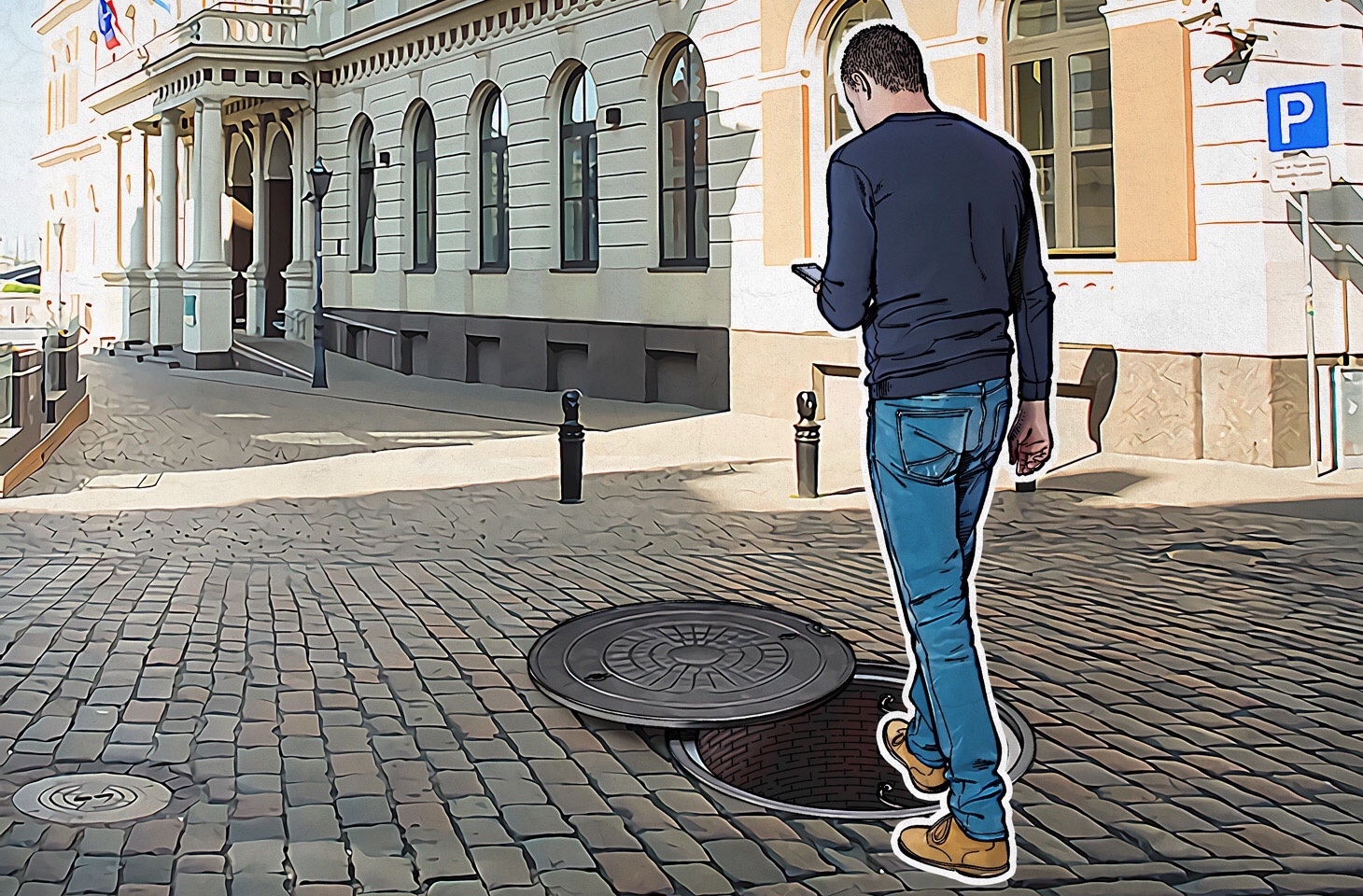

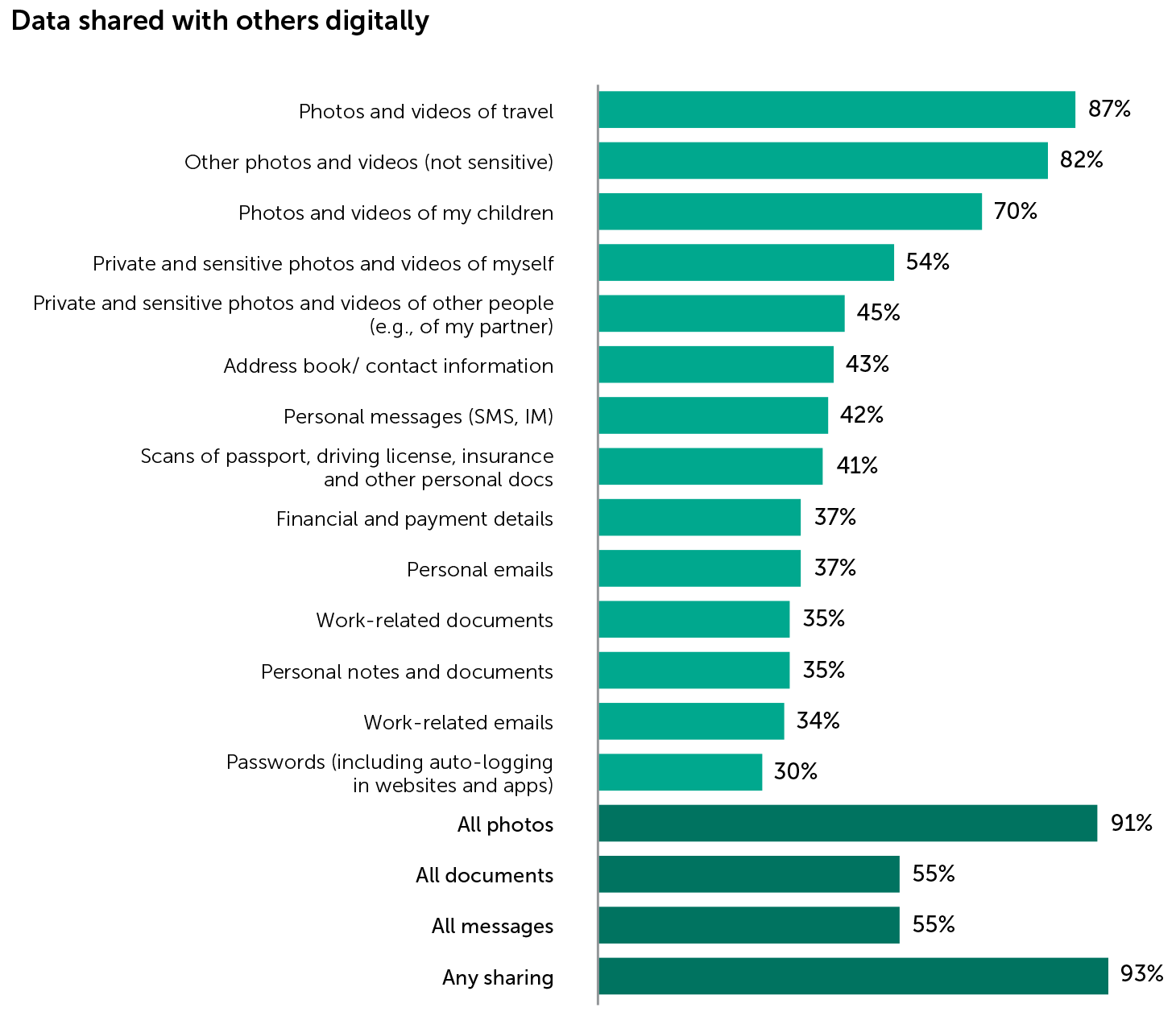
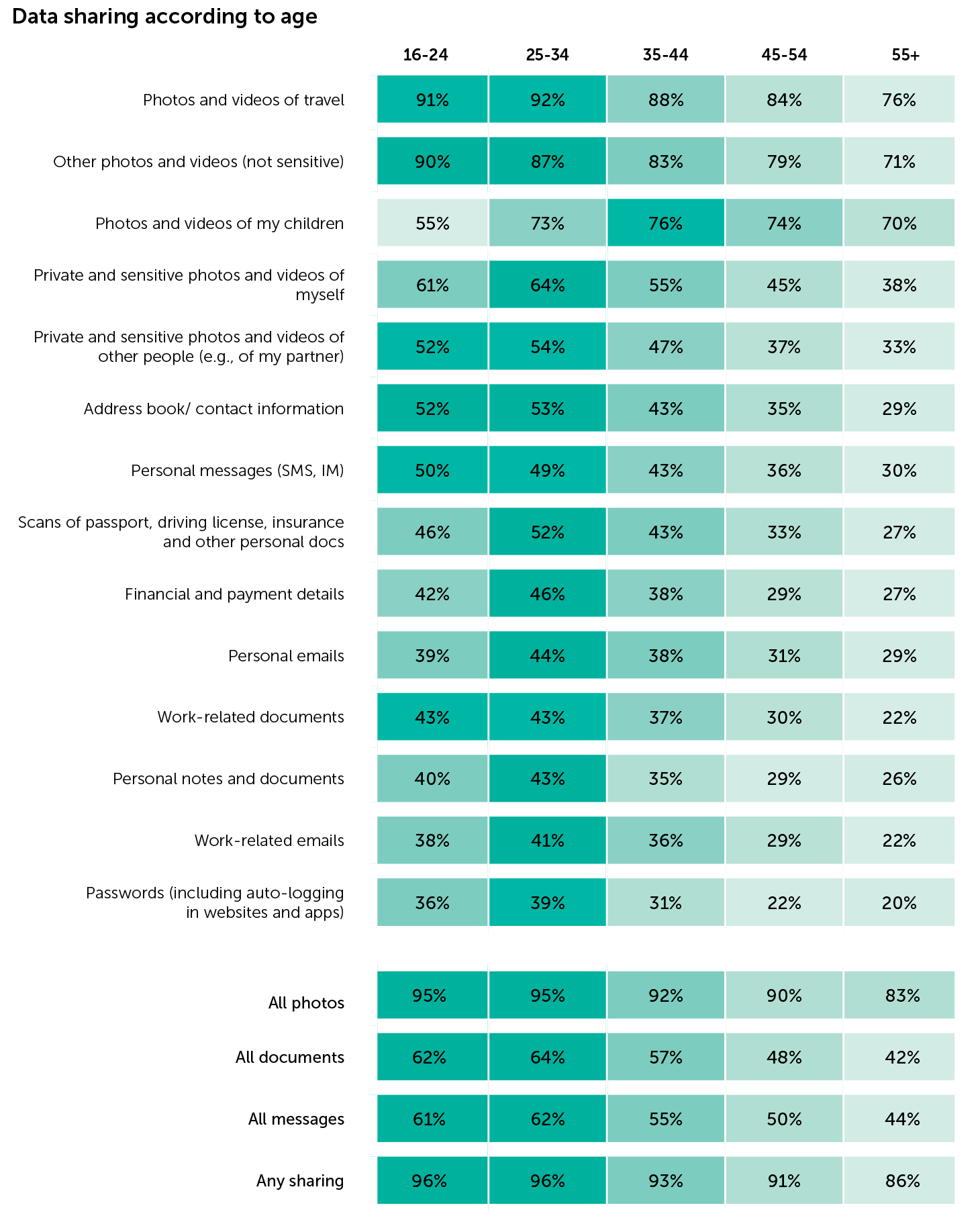
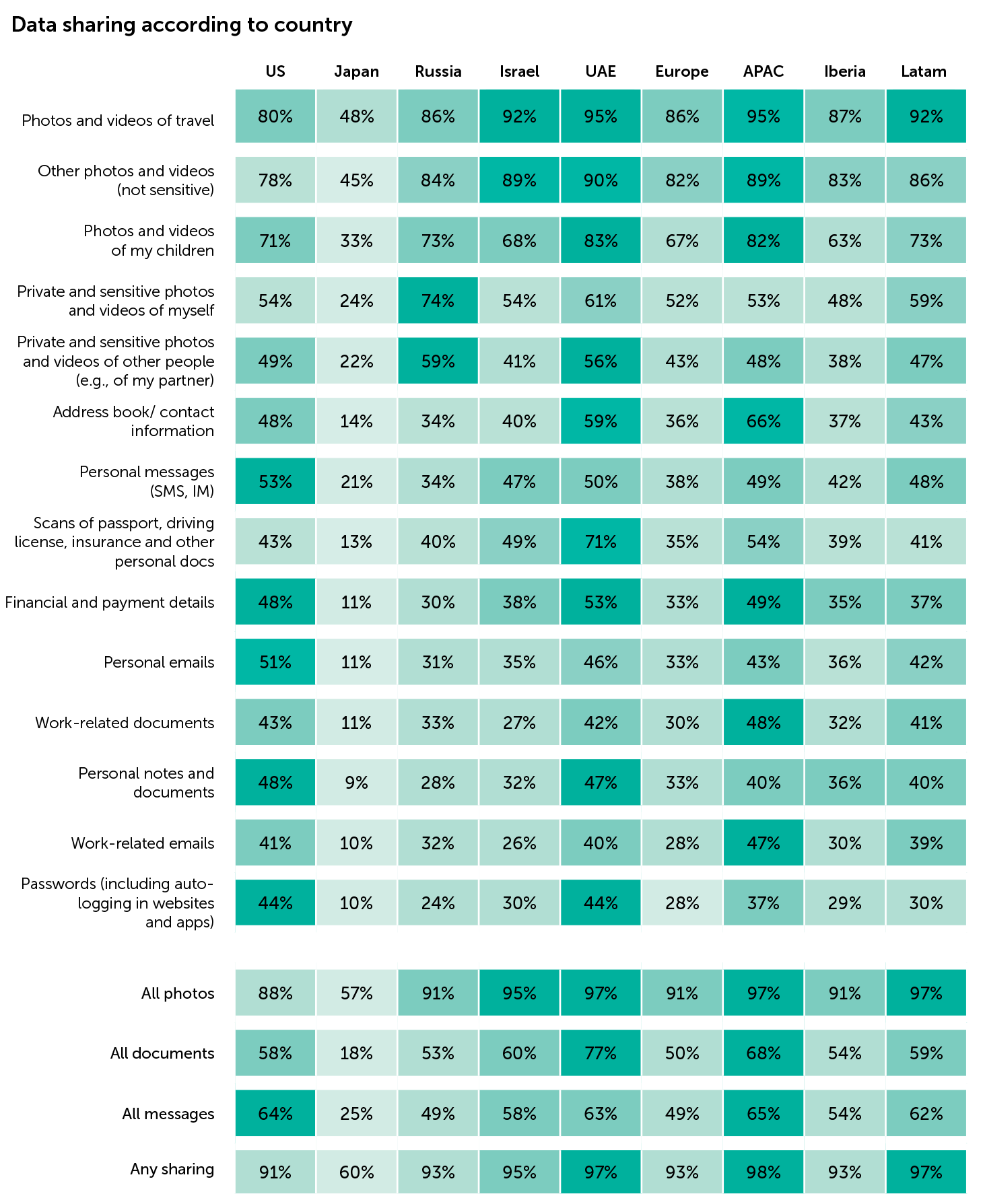
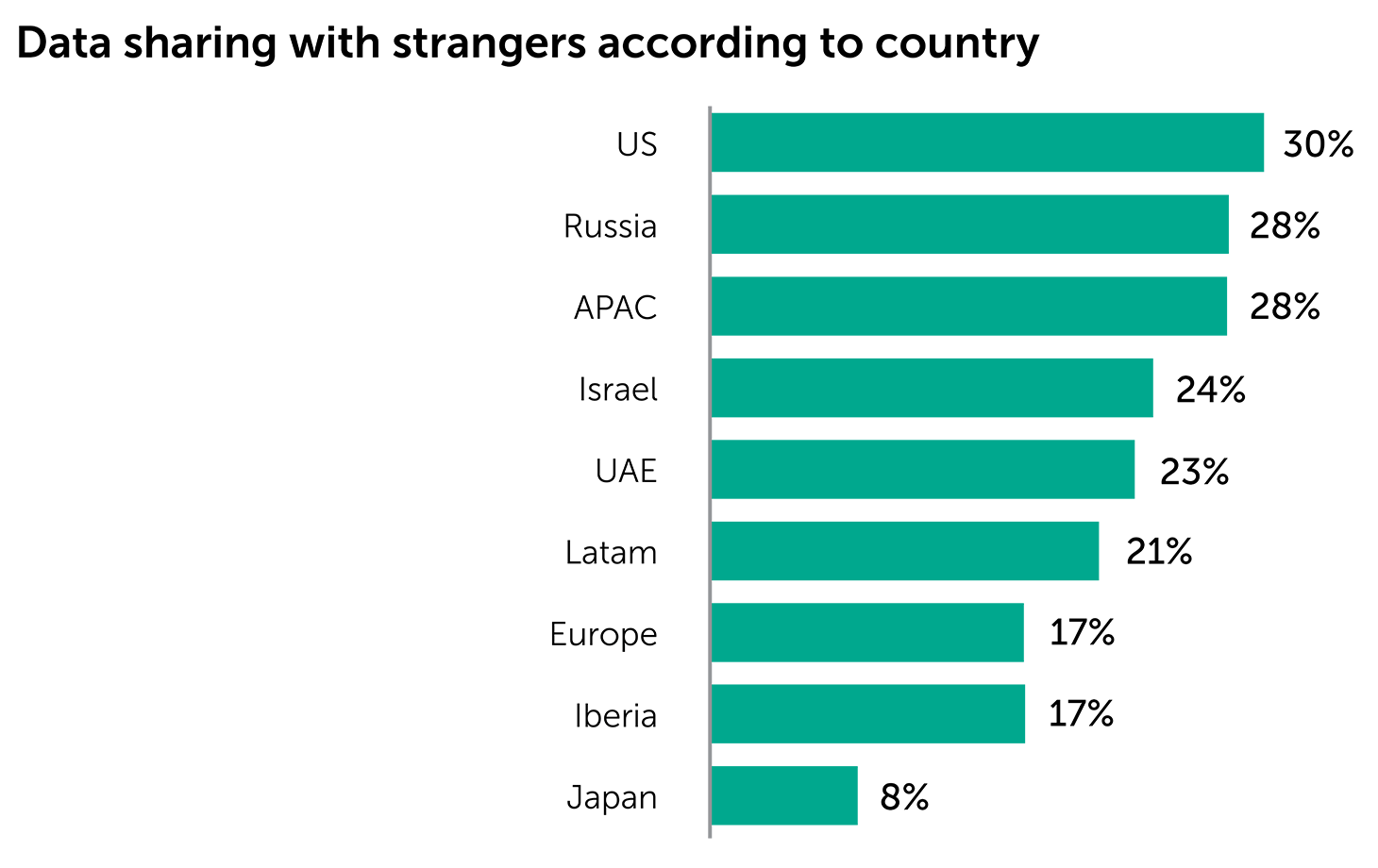


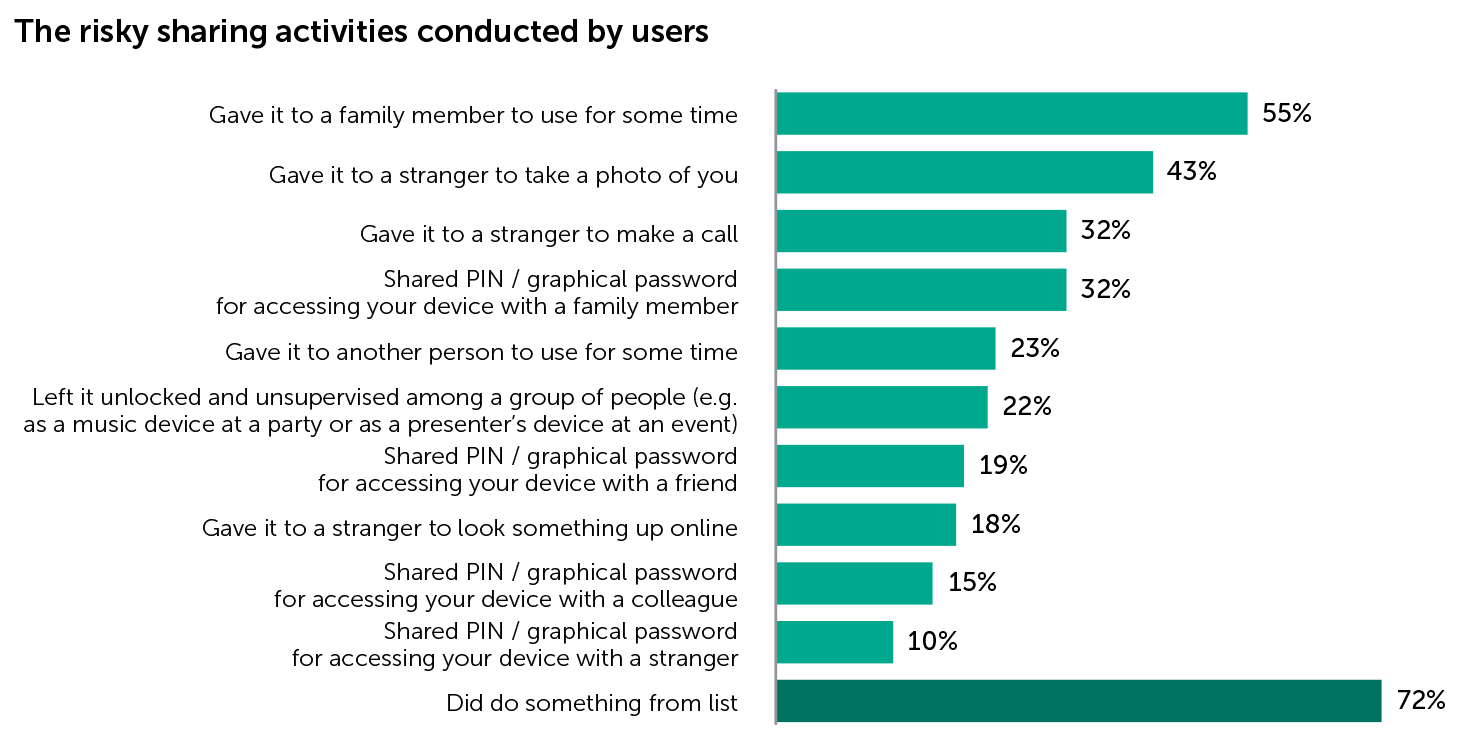
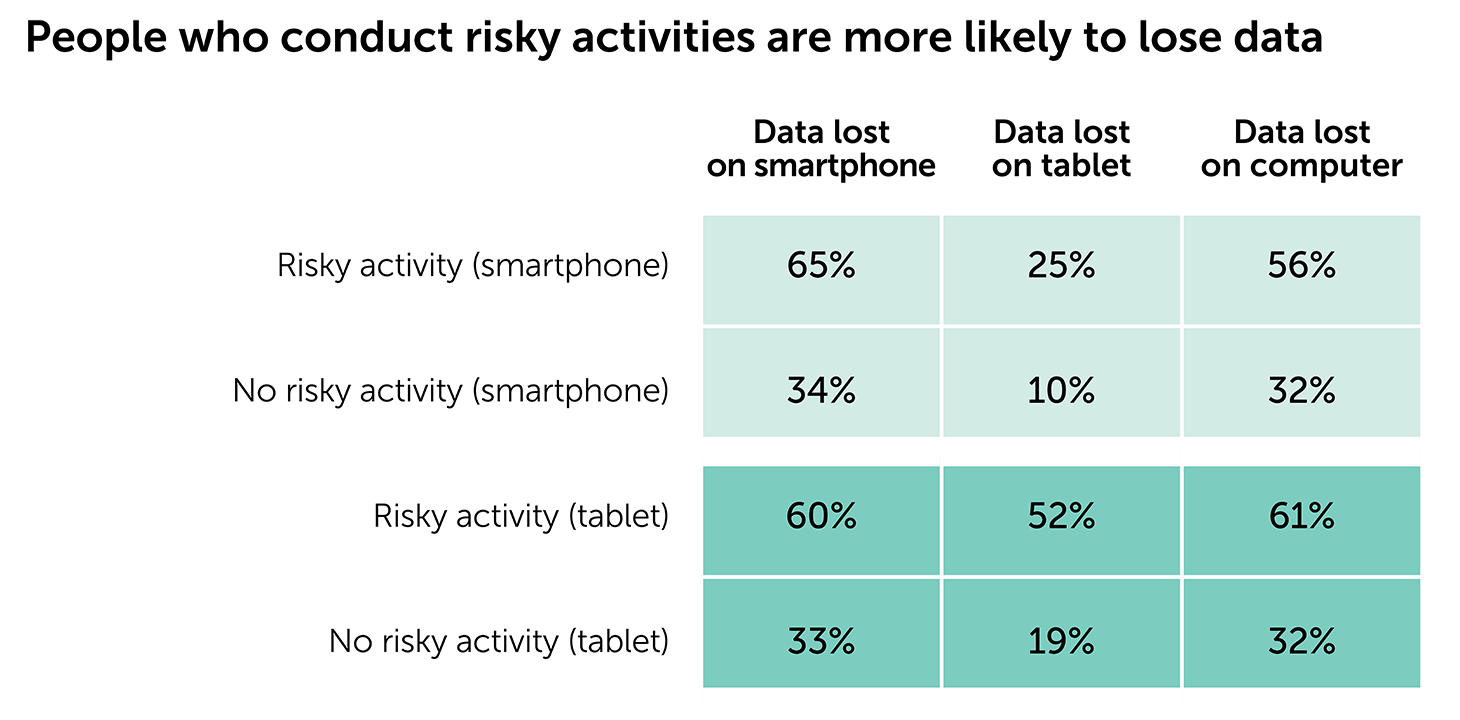

 Tips
Tips